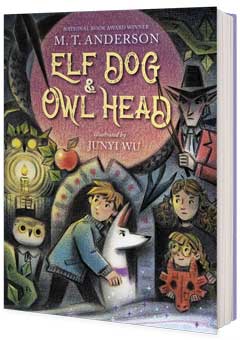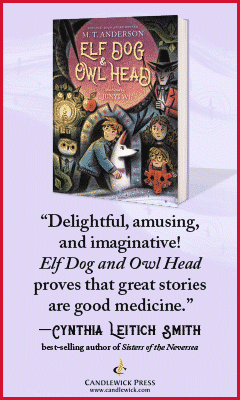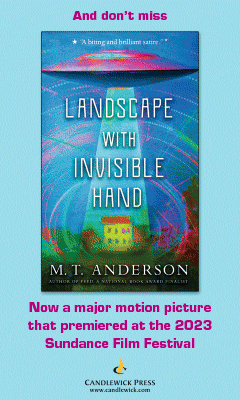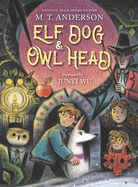Elf Dog and Owl Head
by M.T. Anderson, illus. by Junyi Wu
National Book Award-winner M.T. Anderson (The Astonishing Life of Octavian Nothing) fabricates a heady, inventive and waggish escape into a parallel magical world in Elf Dog and Owl Head, dreamily illustrated by Junyi Wu. During an unnamed global pandemic, Clay makes friends--and enemies--from marvelous and sometimes terrifying corners of the multiverse.
Everything has been shut down, including school. Lonely Clay, frustrated with his family and online schooling during the "worldwide sickness," ventures into the woods with a Frisbee even though "there is no dumber game to play alone than Frisbee." He crosses paths with a "wyrm" (a monster with blue scales, crooked claws and a toothy mouth) and a thin white dog with red pointed ears and a "glitzy" collar. Both creatures have accidentally escaped their own world. After the dog--whose name, Clay learns, is Elphinore--saves him from the wyrm, she follows him home. In the days that follow, Elphinore walks in the woods with Clay; when he lets her lead, she chooses to introduce him to "the magical paths or the tracks that [lead] through time," which are hidden all around him. At the end of one such path is a town inhabited by strangely formal, old-fashioned folk with owl heads on human bodies. When an owl-headed boy named Amos comes to Clay's house late one night, the two form a friendship based on mutual cultural curiosity and an eagerness to connect with someone else interested in chatting, exploring and throwing sticks for the dog. But as so often happens when bored young people get together, they soon stumble into more adventures than they counted on.
There's the time Elphinore awakens an eons-old depressed blue giant by digging in his nostril. Another time the boys decide to experiment with the folds between the worlds and Clay is attacked by the same wyrm he encountered the day he met Elphinore. Meanwhile, Clay is determined to claim Elphinore as his own, even once he learns that she may be a royal hunting dog belonging to the vengeful People Under the Mountain. Amos does not approve, but he's not the kind of person who tries to force his opinion on another. Clay's mulishness about the dog, as well as both boys' insistence on continuing to meet in the woods, despite Amos's elders' cultural edicts against interacting, lead to serious repercussions.
As the boys venture into each other's cultural and physical landscapes, their perspectives on their own lives expand. When Clay asks why it's important for Amos's people to stay hidden from his people, even if the human-heads just want to walk near their villages, Amos says, "The human-head people never simply walk somewhere. They always burn and flatten." Irritated, Clay asks Amos to stop calling them "the human-head people." Amos is baffled: "But you have the bodies of people with the heads of humans."
The straight-faced humor of Elf Dog and Owl Head balances gentle messaging about the risks and rewards of one group of people insinuating themselves into (or storming) another's domain. When they meet for the first time, for example, Clay politely offers Amos some peanut butter crackers. "Among my kind," Amos explains, "the polite thing is to lead your guest first to your basement. It is dark and cool there, and it shows you are willing to offer the pick of all your rodents." Clay graciously complies. On the "risks" side of things, though, Clay takes a shaker with magical powder from the owl-head people when he sees that it makes plants grow. He hopes to help with his family's garden since the "sickness" has made money tight this year. Unfortunately, and not surprisingly, the magic misfires. Soon, a catfish is swimming in Clay's sister's bath, a wheat field is growing out of his other sister's sandwich and his father's polyester-blend work shirt has been transformed into a tiny dinosaur with sleeves and "Barry" sewed in cursive on its hip. Things get really rough on Midsummer's Eve, though, when the gates to all worlds open and beings "usually hidden from the eyes of human-head people" are visible as they celebrate with music, dance, games and food. Clay and Amos decide to meet at the festivities even though Amos's people have expressly forbidden their friendship.
In her pencil drawings, Junyi Wu (illustrator of Newbery Honor book Scary Stories for Young Foxes) evokes the darkness and mysteries of the woods as well as the wonder of the worlds Clay and Amos visit. Her use of varying depths of field and partially obscured characters is thrilling, and she is as adept at generating a sense of the swirling chaotic motion of a party (or an attack) as she is at conjuring the waiting stillness and menace of unseen monsters.
Elf Dog and Owl Head is an elaborate fantasy adventure and balm to bored readers' souls. At heart, it is a story about friendship: Clay and Amos's relationship is a hard-won triumph over cultural divisions. And what Clay and Elphinore share is pure, sweet boy-and-dog love, regardless of the worldly folds from whence they came. Anderson and Wu's collaboration has the spellbinding aura of Diana Wynne Jones's the Chronicles of Chrestomanci series, the boy-meets-world charm of Neil Gaiman's The Graveyard Book and the distinct brand of humor and creativity that Anderson brings to every literary endeavor. --Emilie Coulter








